About Cyrille

Once upon a time … August 96, weary of the ordinary pleasures of the seaside, I left my wife and children playing on the beach and went to write a few letters to our friends in France. My children’s felt pens were lying on the table, so I used them to sketch a few scattered scenes to illustrate my letters. I sent out about 20 letters. Back home, at the end of the holidays, I received a very enthusiastic phone call : “your letter was great and we absolutely loved your drawings ! You should become an artist”. In the space of a few days, I received 18 identical phone calls. Eighteen ! That’s a lot !
“Bet I will !”
It was then and there that I decided to become a painter before even having touched a single paint brush. I started with my wife’s watercolor box, my kid’s gouache paint brushes and began my own experimenting. Not taking a few watercolor lessons and learning it all on my own could be considered a total waste of time, but instead, I just see the good side of it: I created my own style !
To be honest, I should tell you that this little talent, stumbled upon at the age of 42, was written in my genes. My mother received the first prize of the Beaux-Arts drawing contest. This small heritage has been transmitted intact to my children who already draw remarkably well.
October 96, when I decided to become a painter, I spent about 9 months painting game birds in still lives. Woodcocks, partridges, ducks, suspended head down on a wall in the very classic (French) manner. Why French manner ? In France, artists have always painted game birds hanging from one leg. I discovered when I exhibited in the U.K., that British birds were hung upside down, hooked by the head.
You already know that Brits are very strange. Why else would they be sitting in the passenger seat of the car to drive on the wrong side of the road?
My watercolor game birds stood out, perhaps, by their light, the freshness of their colors and by the meticulous attention given to each detail. Each individual feather was painted without omitting any reflected light or any shadow. I was painting for my own pleasure, taking all the time I needed to go to the end of my dreams, creating beauty…..
Follow this link to learn more about Cyrille and to view more of his work
HOW TO PAINT WITH 4 PIGMENTS BY CYRILLE JUBERT
My palette :
cobalt blue, yellow ochre, magenta et indigo. The indigo will allow me to create dense colors, close to black, while melting it with ochre and magenta. The cobalt melted with the same two pigments, will give me light shades of grey close to white.
Watercolor paper:
Arches 140 Lb Hot pressed 12″ x 16″ . For once, I did not stretch my paper before painting.
Drawing:
“A beautiful watercolor is first a great drawing”. I drew my portrait in Paris, to be able to paint at once in front of my students with a light 3H graphite pencil.
Learn to see
The most important teaching of this page is perhap’s to learn how to look at the reflected colors on your subject, in deep or light shades. Try “to see” with an artist eye who exagerate contrasts and colors. It is rather easy if you start with photos. When you will be more familiar with this way of seeing, perhap’s ill you look at life differently.
REFERENCE PHOTO
On the left :
The photo portrait of a drathar. Concentrate your eyes on his left ear. Do you see the blue reflection on the top of it ? and one inch on the richt, the violet-blue lock that become purple and ochre blond in the sun light ? Now look at the top of the skull. Do you see the blue, violet or purple shades, where the fur reflects the dark sky, while the fur on the forehead reflects the ocre and orange colors of the sunset?
On the right:
The same photo contrasted with photoshop to exaggerate these reflections. I drew blue, yellow and red lines pointing to the strongest shades in the dog’s fur.
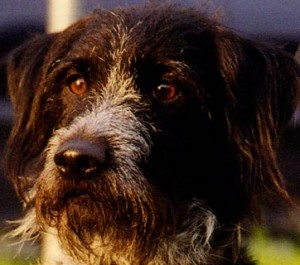 |  |
First glaze
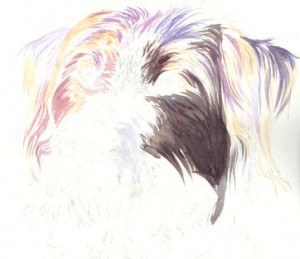
The first glaze will give roughly the prevailing colors in the fur.My aim for that portrait painted in a workshop was a demonstration.So I ovedid a bit, and exaggerated the colours. But I think now that it gave a more artful portrait. Glazes after glazes, these strong colors will melt.
Notice that from the first brush stroke, each lock is painted in the sense of the fur. From the beginning to the end, whatever the size of the brush, you should always comb the hair and remember that each brush stroke will be seen by transparency.
On the right side, this strong color close to black is a mix of indigo, ochre and magenta.
Succeed the Eyes
Is there anything worse than this blind mask ? Before to go on with the fur, I had to create the eyes of the dog to give a soul to the portrait. If the eyes turn out well, the whole painting will be successful.
As I paint in watercolor without adding white gouache, I have to search for the most intense light in the reference photo and always think to preserve it in my painting. My first brush stroke in the eyes will be for this white sparkle in the middle. I shall use a very light glaze of cobalt blue. So light, that I dont see the pigments when it is done. Nevertheless, I think it is really necessary.
Working on the iris, I paint a very light glaze of ochre and let it dry. The next glaze will add a mix of ochre and magenta on the edge of the iris. Then I start to paint the pupil with a mix of my three colors, close to a dark brown-red. I did not try to find the exact shade at my first glaze, not even the exact shape.
Colors are relative data:
Their values change with their immediate surrounding. Consequently, I shall take my time before to finish the inside of the eye. While painting the eye lids with a very light glaze of indigo, I create a humid light reflection, even if it is not in the photo. I know that such a tiny detail will bring more life in the eye.
Now thet my first glaze of the pupil is dry, using a very dark mix of pigments based on indigo, I paint the edge of the sparkle in the eye and what is pehaps the heart of the pupil.
NB: I painted these eyes during the workshop. As we used to scan the portrait only once a day, I cannot show you images of all the stages. I shall try to create a special watercolor lesson, step by step, on “painting the eyes”.

A few steps further, details of the same eye. As you may see, instead of adding a glaze on the iris to get closer to its brown red color, I chose to keep the transparency of the thin original ochre layer and added red-brown streaks. They give at the same time more volume to the eye.
The lower eyelid was not painted in one horizontal brush stroke, but with small vertical strokes to give matter and volume. On the upper eyelid, you see my three basic colors : blue, yellow and magenta.
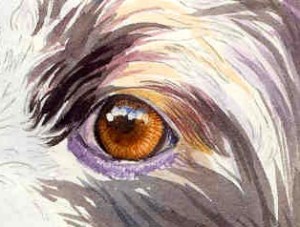
On the eyebrow but also on the top of the head, I paint the wooly fur with “tremolo” brush strokes. Even if I paint stronger glazes over it, your eyes will see it and feel the impression of wool.
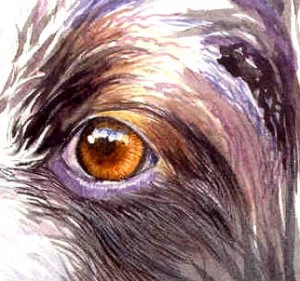
On the final image, the basic colors are still there, as strong as at the beginning: The magenta and indigo mixed in a deep violet blue sing beside their opposite colour ochre.
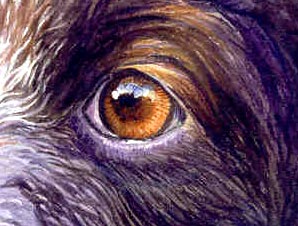
A very humid nose
Most of the time, ahealthy dog has a very humid truffle. The nose of the dog will allow the painter to give light, life and brio to his portrait. So take your time to succeed it. Underneath, a blow-up of the first glazes. The above of the nose has been painted wet on wet, with a light cobalt shade and a darker mix on the right side, where you can see a few magenta and ochre pigments. With a large brush I sucked part of the cobalt pigments to give more light on the top.
On the left, you see the first glaze of the nostril. On the right, the attempt to paint its relief. It seems perhaps difficult to realize, but it is not. Have a closer look. You have streaks to the right crossing streaks to the left. Easy and quick, but giving a great effect, even with darker shades painted over it.
The proof underneath !

As the fur was getting more color and contrast around the nose, I dared to give more value to my nose. I damped again all the top of the truffle and part of the fur around it, before to add a mix of cobalt and magenta, wet on wet , wthout laying any pigment on the light. The hole of the nostril is painted with indigo, magenta and ochre, wet on wet first. Then dry on dry. The darker the shadows, the brighter the light.
This detail shows the fine work on the dog moustache. Once more you can see brush strokes of pure colors, whose shades are changing by superposition.
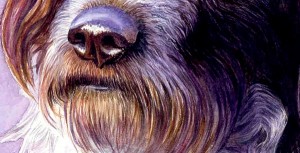
Complementary colors
The blind mask of the beginning take sense as soon as the eyes appear. The whole head is searching for its balance between truffle and eyes. Consequently, You have then to counterbalance colors and masses.
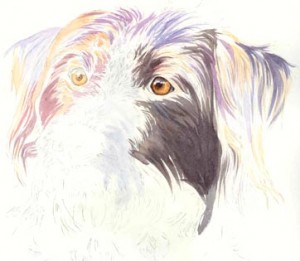

A dog portrait close to “Fauvism”
Notice the background:
Nearly pure ochre at the bottom right, pure cobalt on the top left and a violet blue (cobalt-magenta) at the bottom-left painted wet on wet.
Dedicated to my friend, Nina Gagarin.
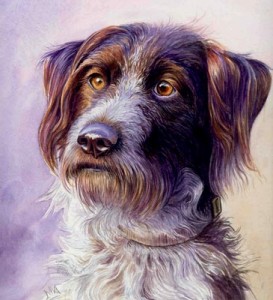
I hardly worked 3 days on this portrait during this workshop in Palm Beach. So it is not really finished.I could hardly be concentrated enough during the workshop hours, while each one of my students was hoping for my particular attention and advices on their own work. On sunday, I painted about 10 hours as on monday morning, I had an appointment in a gallery to present my paintings. This Fine Art gallery uses to present each year in Palm Beach, the Willian Secord’s dog paintings. Beyond my prints and press-book, I needed a portrait to loud me to the sky. Please, tell me I succeed !
I did not meet him, but he saw my work. Next year perhap’s ?
Last glanceLook at this photo in B&W. Interesting, is not it ?
| 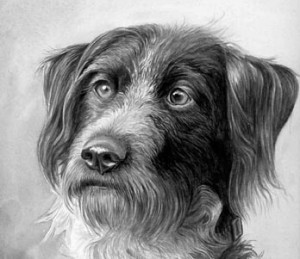 |
Brilliant. I would love to see more on just the eyes.
Thank you very much for sharing this piece. Cyrille’s work
is wonderful.
Cyrille’s use of a limited pallet really makes you think about the color blending; that we have all basically studied, and not limit ourselves to the colors we have on hand. Great article, thank you.
i enjoyed this site before and this lesson about the dog was special. funny and great tutoring. i plan to become a member and hope you’ll allow me to use some of you instruction to pass it along to some of my friends so they can practice too. i’ve sent the web address to quite a few. thanks. kay
I would like to see portraits of humans and figure paintings
wow — absolutely beautiful — thank you so much for sharing
I am going to try this one
June Smith
it’s so real… in indonesian we call it “indah” or beautiful. i’ll try even it’s hard.
Great!!!! Am still a beginner in watercolor and seem to have, for some reason, gotten into painting dogs. Your lesson has helped me tremendously.
thanks a bunch\Betty
What brushes are you using for doing this dog picture or dogs generally? Sometimes I have a problem doing dogs, animal fur.
GOOD EVEING SIR..
IT’S A STUNNING PICTURE. I AM JUST A BEGINNER. I NEVER KNEW THERE IS A PAINTING LIKE THIS. THANK YOU FOR STEP BY STEP LESSONS.
Thank you so much for the information. I’m working on cat hair right now. I know there is something that I need to change because the hair is not looking natural enough. I will study your lesson and see if it helps. I hope you have a nice day.
Beautiful portrait! Thanks for sharing your tips. The fur looks so real, the texture and modeling is excellent. This dog has soulful eyes and you captured it so well.
Impressive. Look at the eyes, they just glare like it is so real! You are such a great artist. I tried to paint before and I am having a problem with the eyes. It always look so dull. I will try your easy steps (hopefully that would be easy for me too).
Fantastic work. The color and shades are so clear and detailed. Thanks for sharing the information. I am learning paintings too so this is a great help for me on how to become effective with painting.
great instruction with color, just what I needed to start my project , I love to paint animals and their eyes especially, tell all, would love a book of demos from you. Thanks
This Portrait is really exquisite! The palette you have chosen gives it a certain elegance, as well as heightened expression. Quite a challenge to portray overlapping tufts of white fur like that without resort to an opaque medium.
Glad to have come across your blog! 🙂 I was struggling with watercolor painting in my 20’s. I’ve never been a quitter .. until then. Watercolor was just an extremely tough medium for me that I eventually found myself giving up on it and moving on to other art forms. You made me want to try my hand in it again. 🙂
This is so beautiful,,,,,,,,,,,,,,,,,,, wo wo I like it
wow! nice one.. I believe that painting is a talent. There is 2 important thing about painting. 1st is having a good hand then second is you should have a good state of mind in order to illustrate a very awesome outcome like this.
It is amazing the variations you can get with a limited palette. Some people don’t realize that with a well choosen red, blue and yellow you can mix almost any color. But the real secret to painting is having a good foundation in drawing skills. Thanks for sharing.
I’ve taught dog obedience for 30+ years and finding your site has made my day! Do you have any videos on painting dogs? Your painted animals are “alive”…thank you!